If you’re looking at the 2015 Acura RDX and thinking “That looks familiar”, it’s hardly surprising. The RDX has become a top seller in a robust segment, slipping past the Mercedes-Benz GLK to sit in second spot overall among small luxury SUVs this year, just behind the bestselling Audi Q5.
The current, second-generation RDX debuted in 2012 for the 2013 model year, and it has continued essentially unchanged since then, with a new Kona Coffee colour introduced for 2014 and no further changes for 2015. Clearly, Acura feels it got this one right, and it’s tough to argue that given the RDX’s solid sales record and positive driving impressions.
I’ll be the first to admit that I’ve had a hard time embracing the crossover trend, preferring either the handling purity of a good sedan or, when necessary, the more all-out practical nature of a minivan (my family’s personal wheels reflect this, with a VW Vanagon sharing garage space with our ’90s-era BMW 3 Series).
During my week with the RDX, however, I think I finally got it.
Maybe it was the weather that made the difference, with dark early nights and monsoon rains creating lakes and rivers across Vancouver’s roads. It was certainly nice to have the extra ground clearance needed to press on through a low spot along Stanley Park Drive when limousines and small hatchbacks were getting swamped and drowned mid-stream.
Perhaps it was the “carved from a solid block of granite” feel of the RDX: The doors close with a muted thud, and the interior is a hushed, cocooning space.
Possibly it was the experience of taking my wife and mother-in-law shopping: Not only did my mother-in-law coo over the RDX’s well-fitted interior (I don’t even own the vehicle, yet it still raised her opinion of me by several notches), but also I didn’t have to worry when she impulsively decided to purchase a tall bathroom cabinet. “No problem,” I said, “the car has split folding seats so we’ll be able to fit everything in.” An added bonus is the convenient release levers in the cargo area that make folding the seats a snap, and the intelligently designed power tailgate that lets you easily override it for quick manual operation.
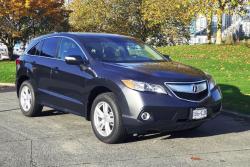 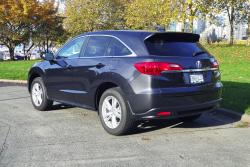 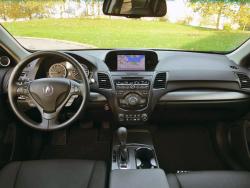 2015 Acura RDX Tech, dashboard. Click image to enlarge |
Most likely it was a combination of all these things, aided and abetted by the RDX’s willing and capable engine, its well-sorted suspension, and the awesome-sounding 10-speaker audio system included with my test vehicle’s Tech package. For sure, the RDX isn’t as plugged-in feeling as a good sedan, nor even as some of the more performance-oriented crossovers out there for that matter — but it’s still really rather good in a nice middle-of-the-road kind of way, and it’s just the right size to be genuinely functional yet not unwieldy around town.
Under the 2015 RDX’s hood, Acura eschews turbochargers and multiple engine choices and sticks instead to a simple, tried-and-true formula, fitting all RDXs with a 3.5L 24-valve V6 that cranks out an ample 273 hp and 251 lb-ft of torque. The engine is hooked up to a six-speed automatic transmission driving all four wheels, with power distribution monitored and adjusted by Acura’s AWD with Intelligent Control system. This normally runs things in front-wheel-drive mode for efficiency, and shifts up to 50 percent of the power to the rear wheels as needed if the front wheels begin slipping (it’s essentially the same system as in the Honda CR-V).
From behind the wheel the V6 has a deep, mellifluous exhaust note and a pleasantly responsive nature, and it’ll haul the 1,749-kg (3,855-lb) RDX from 0 to 100 km/h in just under seven seconds. The automatic transmission shifts crisply and smoothly, favouring higher gears for better efficiency when in Drive, and offering a Sport mode if you prefer more aggressive shift timing. There are also paddle shifters for when you want to take active control. In manual mode the transmission is sporty enough during downshifts (it makes nice rev-matched gear changes), but it auto upshifts from first to second whether you want it to or not, and there’s a bit of lag between when you click the shift paddle and when the shift executes (maybe a half-second, so not bad, but definitely noticeable).
Thanks to the AWD with Intelligent Control system and Acura’s Variable Cylinder Management (which can shut down three of the engine’s cylinders during low load operation to conserve fuel), fuel economy is reasonable, with the 2015 RDX rated at 12.1/8.7 L/100 km in city/highway driving using the new five-cycle test process. I averaged somewhat worse than the rated city number, using 13.5 L/100 km in purely city driving, but I should point out that this was mostly in the cold and rain while either stuck in stop-and-go traffic or fording spontaneous pop-up rivers. My colleagues have reported getting much better mixed fuel economy averages of around 9 or 10 L/100 km under more reasonable circumstances. I should also mention that the cylinder deactivation operates seamlessly in the background, and you really don’t notice it doing its thing.
The suspension (MacPherson struts up front and multilink in rear) provides a ride that’s taut but not harsh, with decent handling for this segment. Likely helping in this regard is the RDX’s low centre of gravity compared to most crossovers, and its Amplitude Reactive Dampers. These feature two piston valves per shock absorber rather than just one, with the primary piston absorbing minor road irregularities and the stiffer secondary piston reining in larger suspension motion. So you get a soft response if the wheel encounters a small, sharp bump, and a firmer, more controlled response if the wheel is moving through a larger range of motion such as when negotiating an undulating corner.
Inside, there’s soft touch material on every surface you might expect, including the front and rear door uppers, armrests and dash top, with rigid plastics making up the lower dash and door lowers as expected. One thing that could use an upgrade would be the A-pillars, which are hard plastic but would create a more premium feel if they were cloth-wrapped.
Trim choices are limited to the base RDX (starting at $43,385 including the $1,995 destination fee) or the RDX Tech (starting at $46,385 destination in). At this price point the RDX sits several thousand dollars below the Mercedes-Benz GLK (which starts at $50,675 delivered with the diesel engine) and a few hundred dollars below the Audi Q5 (which starts at $43,895 with destination provided you’re okay with black or white paint, and $890 more if you want a metallic colour).
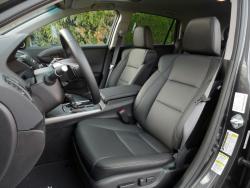 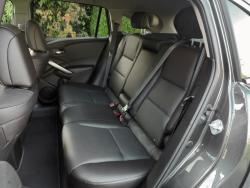 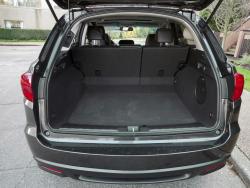 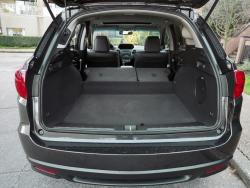 2015 Acura RDX Tech seating, cargo area. Click image to enlarge |
Standard features with the base RDX include dual-zone automatic climate control, power sunroof, power locks with proximity entry, push-button start, power windows, leather upholstered seating with heated power-adjustable front seats, 60/40 split folding rear seats, leather-wrapped tilt and telescoping steering wheel, interior ambient lighting, active noise cancellation, cruise control, rear-view camera, auto-dimming mirror, universal garage door opener, automatic HID headlights, fog lights, 18-inch alloy wheels, and a seven-speaker AM/FM/XM/MP3 audio infotainment system with 5-inch display, Bluetooth phone connectivity, Bluetooth audio streaming, auxiliary input and USB port.
The Tech package adds an upgraded 10-speaker audio system with 8-inch display, navigation with voice recognition, GPS-linked solar-sensing climate control system, and power tailgate.
Missing from the features and options list are things like blind spot detection and lane departure warning or active cruise control with collision mitigation (which is a bit ironic considering you can get them on a Honda CR-V). Frankly that’s just fine with me as I prefer the less costly and less complicated approach, but if these types of driver assist technologies are important to you then you might want to consider competitors such as the Volvo XC60, Audi Q5 or BMW X3.
I appreciated the RDX’s comfortable seating and abundance of onboard features, although I did find that operating some of the features took a little getting used to (possibly because I was trying to learn while driving in the dark, in a monsoon rainstorm). The centre stack controls are reasonably well laid out, but there’s a lot of information to take in and the controls and display are mounted fairly low, with the result that I initially struggled to find heater mode switch, for example.
I also found the infotainment interface to be a little confusing. It has several layers of menus, and different main selections depending on whether you push up or down on the main controller knob, and on several occasions I found myself scrolling hopelessly through the wrong menus while trying to locate a function. It’s true that I tend to take a “press-lots-of-buttons-and-hope-for-the-best” approach to learning new system interfaces, but I’m usually pretty good at sussing them out, and this one baffled me more than most.
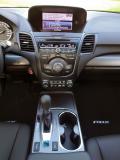 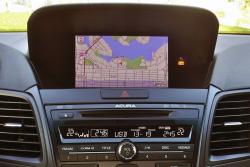 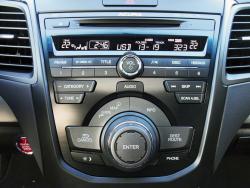 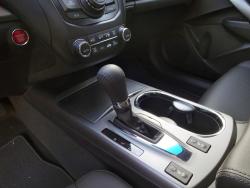 2015 Acura RDX Tech centre stack, navigation, shifter. Click image to enlarge |
Other nitpicks include the somewhat restricted rearward visibility (no surprise there as the RDX is hardly unique among crossovers in this regard), the lack of retained accessory power when you shut off the engine (unless you remember to shift into neutral before shutting down), the lack of a cargo cover, and the pedal-actuated park brake (in this segment it really ought to be either a leather-wrapped handbrake or an electronically actuated setup). Last but not least, I was unable to get Acura’s Bluetooth system to work properly with my phone (not the first time I’ve had this trouble with an Acura). I’ll admit my three-year-old phone is a less-than-popular model, but still, most other systems have no problem with it. At any rate it’s worth checking that your own phone is compatible, just in case.
In most other regards the RDX really does hit the small luxury crossover nail on the head. It’s a simple but well-executed design that’s undemanding yet reasonably responsive to drive. It feels solid but not bulky, and has all the features and comfort that you really need, without unnecessary cost and complexity. You could argue that it’s a bit unremarkable and in a sense you’d be right, because other than its somewhat divisive styling it doesn’t really stand out in any particular way. Instead what it does is provide practical daily transportation with a luxuriously serene cabin and a versatile 739 L cargo-carrying capacity (2,178 with the seats folded), all for an attractively competitive price. And that’s exactly what most crossover buyers are looking for.
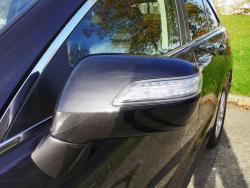 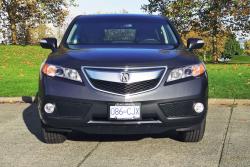 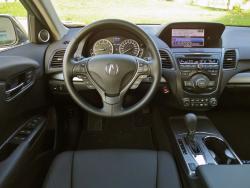 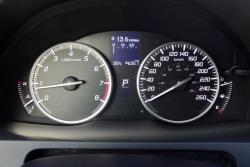 2015 Acura RDX Tech, driver’s seat, gauges. Click image to enlarge |
|
Manufacturer’s Website: Acura Canada Photo Gallery: Crash Test Results: |
Pricing: 2015 Acura RDX Tech
Base Price: $44,390 (RDX Tech)
Options: $0
Freight: $1,995
A/C tax: $100
Price as tested: $46,485
Competitors:
Audi Q5
BMW X3
Lexus NX
Lincoln MKC
Mercedes-Benz GLK
Volvo XC60
















